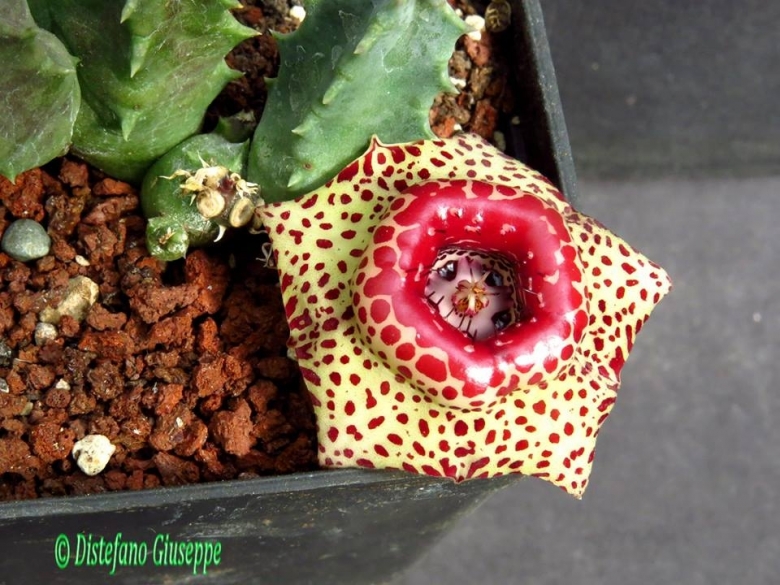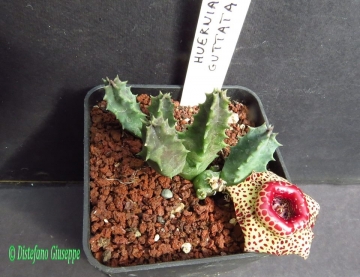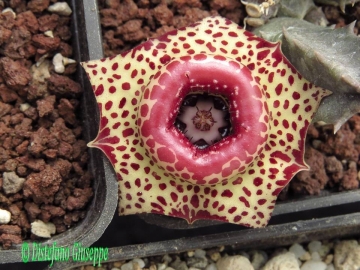Accepted Scientific Name: Huernia guttata (Masson) R.Br. ex Haw.
Syn. Pl. Succ. 30 30 1812

Stapelia guttata (Huernia guttata) Photo by: Giuseppe Distefano
Origin and Habitat: Eastern Cape, Northern Cape, Western Cape. The typical plants occur mainly in the Eastern Cape from Somerset East southwards towards Kirkwood and at Uniondale.
Synonyms:
See all synonyms of Huernia guttata
back
Accepted name in llifle Database:Huernia guttata (Masson) R.Br. ex Haw.Syn. Pl. Succ. 30 30 1812Synonymy: 11
Accepted name in llifle Database:Huernia guttata subs. reticulata (Masson) BruynsStapeliads S. Africa Madagascar 1: 181. 2005Synonymy: 7
back
Description: Huernia guttataSN|22523]]SN|22523]] is a small, tufted perennial succulents with upright, thick, toothed, 4- to 5- angled stems usually less than 7 cm tall. Its beautiful 5 lobed flowers appear in groups of 2 to 4 at the base of new shoots. The bell-shaped corolla has five lobes with appendages between them and a conspicuous, convex fleshy ring or annulus with a shiny surface in the centre, the inner face is yellow and dotted with crimson, the marks are much larger, sometimes confluent on the annulus, but quite variable. The typical plants are recognised by their smaller flowers, spotted or lined tube and dull annulus with short inwardly pointed hairs at the tube mouth.
Hystory: Huernia guttataSN|22523]]SN|22523]] was one of the earliest species described (by Masson at the end of the eighteenth century) which was lost to cultivation for over 120 years before rediscovery in Cape Province.
Stems: 5-7 cm high, deflexed or creeping to upright, 12-18 mm thick, acutely 4–5-angled, glabrous, green, glaucous. Ribs with acute deltoid slightly recurved teeth 2-3 mm long.
Flowers: 1–5 together near the base of the young stems, developing successively, facing upwards. Pedicels rather slender, 12-30 mm long, glabrous. Sepals 5-7 mm long, lanceolate-subulate, glabrous. Corolla flat-topped and 5-angled in bud, with 5 short incurved teeth at the angles and five prominent ribs radiating from the short central point, 2-3.5 cm across when expanded. Tube campanulate or subglobose-campanulate, slightly constricted at the mouth marked with transverse lines, basally slightly rugose around the corona. Limb saucer-shaped, lobed to half-way, spreading very abruptly from the tube and raised into a very conspicuous broad convex annulus around its mouth, with ascending-spreading lobes, 8-10 mm long and broad, deltoid, acuminate with a finely papillous edge; outside greenish, smooth and glabrous; inner face with some scattered fleshy spine-like processes, stiff, sometimes clavate (not hairs) 0.5-1 mm long at the throat of the tube and around its mouth upon the otherwise smooth ring, minutely papillate on the rest of the limb and lobes, white to yellow, stippled or dotted with maroon to crimson to the tips of the lobes (becoming confluent on the annulus). Corona 4.5 - 5.5 x 6 - 8 mm. Outer corona divided into 5 pairs of narrow acute teeth nearly 2 mm long, notched to incised or elongate and deeply bifid with variable colours, usually light pinkish or whitish with purple margins to the teeth and a blackish ring at the base around the staminal column, enlarging into 5 rounded spots opposite the pairs of teeth. Inner corona-lobes mostly cream-coloured with maroon markings, apically dark,about 3 mm long, subulate, acute, connivent at the lower part over the style-apex, then rather abruptly spreading, with up-curved tips, apparently yellow often with nectar droplets. Pollinia yellow, germination mouth region brown.
Subspecies, varieties, forms and cultivars of plants belonging to the Huernia guttata group
 Huernia guttata (Masson) R.Br. ex Haw.: (subsp. guttata) although variable it has smaller flowers, spotted or lined tube and dull annulus with short inwardly pointed hairs at the tube mouth. Distribution: Eastern Cape, Northern Cape, Western Cape.
Huernia guttata (Masson) R.Br. ex Haw.: (subsp. guttata) although variable it has smaller flowers, spotted or lined tube and dull annulus with short inwardly pointed hairs at the tube mouth. Distribution: Eastern Cape, Northern Cape, Western Cape. Huernia guttata subs. calitzdorpensis L.C.Leach: has larger, darker flowers up to 7 cm Ø, tube dark maroon, marked with vague yellowish lines, hairs at its throat longer and strongly clavate. Distribution: Little Karoo from Calitzdorp to Oudtshoorn
Huernia guttata subs. calitzdorpensis L.C.Leach: has larger, darker flowers up to 7 cm Ø, tube dark maroon, marked with vague yellowish lines, hairs at its throat longer and strongly clavate. Distribution: Little Karoo from Calitzdorp to Oudtshoorn- Huernia guttata subs. reticulata (Masson) Bruyns: Distribution: Northern Cape, Western Cape
Bibliography: Major refrerences and further lectures
1) N. E. Brown. “Flora Capensis” Vol 4, 1909
2) Doreen Court “Succulent Flora of Southern Africa” CRC Press, 01 June 2000
3) Focke Albers, Ulrich Meve “Illustrated Handbook of Succulent Plants: Asclepiadaceae: Asclepiadaceae” Volume 4 Springer Science & Business Media, 2002
4) James Cullen, Sabina G. Knees, H. Suzanne Cubey “The European Garden Flora Flowering Plants: A Manual for the Identification of Plants Cultivated in Europe, Both Out-of-Doors and Under Glass” Cambridge University Press, 11/August/2011
5) British Cactus & Succulent Journal, Volumes 1-3 page 70. Cactus & Succulent Society, 1983
6) Werner Rauh “The Wonderful World of Succulents: Cultivation and Description of Selected Succulent Plants Other Than Cacti” Smithsonian Institution Press, 1984
7) Vlok, J. and Schutte-Vlok, A.L. "Plants of the Klein Karoo." Umdaus Press, Hatfield. 2010.
8) Foden, W. & Potter, L. 2006. "Huernia guttata (Masson) Haw. subsp. guttata." National Assessment: Red List of South African Plants version 2014.1. Accessed on 2015/02/23
 Stapelia guttata (Huernia guttata) Photo by: Giuseppe Distefano
Stapelia guttata (Huernia guttata) Photo by: Giuseppe Distefano Stapelia guttata (Huernia guttata) Photo by: Giuseppe Distefano
Stapelia guttata (Huernia guttata) Photo by: Giuseppe DistefanoCultivation and Propagation: Huernia guttataSN|22523]]SN|22523]] subs. calitzdorpensis isn't difficult to grow and flower.
Spring: When winter ends and they begin to grow again, they will require much water and soaking the pots will no longer put the plants at risk for rot. In the spring they will grow well in partial shade and leaving them out in the rain may provide them with the water they need.
Summer: In the summer months they will tolerate heavy rain, but will be just as happy if the season is dry. It's best to sort out the stems while the plants are resting in the summer before they begin their autumnal growth cycle. They will tolerate very hot weather outdoors as long as they are kept in filtered light and this will encourage them to flower in the Autumn. They also enjoy some fertiliser. Moving the plants as they are developing buds may cause them to spontaneously abort the flowers all together.
Autumn: In the fall keep them outdoors until the night time temperatures drop below the 10°C.
Winter: Winter care presents no problems at 10° C with plenty of light. As soon as they are flowered be sure to take extra precautions to keep them dry, because damp cool conditions when the plants are resting is an invitation to fungal infections, but - according to temperatures –some occasional lit watering may be useful.
Potting medium: Since roots are quite shallow, use a cactus mix or add extra perlite or pumice to regular soil potting soil. A gritty, very free-draining compost is suitable, and clay pots help the plants to dry out between watering. Re-pot every 2 years.
Pest and diseases: Huernia are generally fairly easy to grow, especially if kept pest-free. They are very susceptible to stem and root mealy bugs, and damage from these may well initiate fungal attack. Any time when there is a dead or dying stem in the pot it is important to remove it immediately and completely before other healthy stems can become ill too, isolate the healthy parts, dry them off, and re-root them in new compost.
Propagation: Easiest with stem cuttings. Allow cuttings to dry a day before planting. Stems must be laid (Not buried) on gritty compost and will then root from the underside of the stems. It can also be increased from seeds sowing in spring in moist, sandy peat moss. Barely cover seeds. Seeds germinate quickly.
In any season it's best to lay the stems out for several days before replanting them and then pot them only in dry soil and withhold any water until they begin to shrivel or start growing again.












